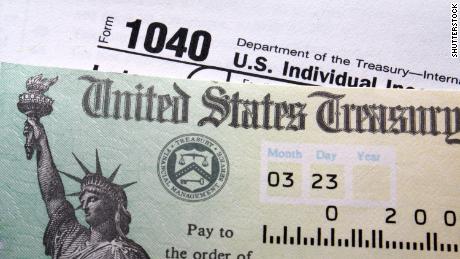(CNN)Most American taxpayers got tax cuts last year, thanks to the new tax law. They just may not have realized it. And filing their returns Monday won't help make it clearer: Refunds have barely risen this year.
Final data from the IRS won't be available for some time, but the tax preparer H&R Block reports that on average, its clients' tax liability -- how much federal tax they paid -- is down by a lot, almost 25%.
But the average refund -- how much they get back from the government after filing their annual returns -- is up just 1.4%. Barely at all. (That's just for people who got refunds in both the 2017 and 2018 tax years. It does not include the people who went from getting a refund last year to paying the IRS this year.)
And there's a political divide: Red states will enjoy the biggest increase in refunds. However, several blue states are seeing the largest average tax cuts compared with last year.
H&R Block processes around 20 million returns each year and its figures here are for returns filed through the end of March.
These numbers will change, since many people who will owe money may not have filed yet. People who expect refunds tend to file earlier, according to Nathan Rigney, lead tax research analyst at the Tax Institute at H&R Block.
$6 billion less in refunds
Less detailed filing season data from the IRS through March 29 shows the government has paid 2.2% fewer refunds so far and the average refund of $2,873 is $20 smaller than it was in 2018. And the IRS has paid $6 billion less in tax refunds this year, almost 3% less than last year.
There's a lot of psychology associated with how Americans pay their taxes, which means people could be seriously disappointed in the massive 2017 tax cut law, which brought them a temporary cut, gave corporations a much larger permanent tax rate reduction and is expected to make the US government's budget deficits spiral in excess of $1 trillion each year starting in 2022.
Most people don't think they're paying less
That frustration has been evident on social media from people who are surprised that the new tax law didn't get them bigger checks at filing season.
"It's that expectation, and this is sort of human behavior about loss aversion: We're a lot more likely to feel the pain of a loss than enjoy that small gain, and that's what we're seeing," said Rigney.
The anecdotal frustration is borne out in polls, which suggest most Americans don't realize they got a tax cut. In an NBC News/Wall Street Journal poll out this week, just 17% of respondents think they are paying less in taxes under the new law, compared with 28% who think they are paying more. Others don't know or said their taxes haven't changed.
How did this happen?
Just before the law passed, Trump used the promise of immediate benefits to help sell it to Congress.
On Dec. 13, 2017, he said: "If Congress sends me a bill before Christmas, the IRS -- this is just out, this is breaking news -- has confirmed that Americans will see lower taxes and bigger paychecks beginning in February" (it was actually March).
And the IRS did change the tables that govern how much is withheld in taxes from people's paychecks throughout the year. While that process -- the subject of a Government Accountability Office investigation -- was shown to be opaque, it did result in Americans getting a paycheck bump in March of 2018. But many may not have noticed, since the tax cut was spread out over the year instead of handed out as a lump sum.
And now taxpayers aren't seeing much of a bump in their refunds. They'd need to change their withholding if they want to get bigger refunds, said Rigney, who pointed out that even more money will remain in their paychecks in 2019, since the new tables will be in effect for a full year instead of nine months or so.
IRS officials and financial planners might argue smaller refunds are a good thing since people are keeping more of their money. But many people rely on their refunds as a sort of forced savings plan.
It could even have a ripple effect on the economy: Retail spending is down compared with recent years and smaller tax refunds could be to blame.
A surprise for high-income filers in high-tax states
Not everything is as expected in the H&R Block data, according to Rigney. In some states with high state taxes, there had been worry that new rules limiting the amount of state and local taxes (SALT) that could be deducted would lead to massively higher tax bills for some. Those fears have now been offset because many fewer people are paying the alternative minimum tax.
"They come out better under the new law," said Rigney. "They get significant rate decreases. They're also not paying AMT and so they're actually allowed to deduct up to $10,000 SALT deduction they didn't get any benefit from in the past."
This generally benefited much higher-income families with many deductions, often between $250,000 and $1 million, he said.
But that shouldn't be a surprise. The tax law generally is much more generous to higher-income filers and families.
Red states vs. blue states
While some states that supported Democratic presidential nominee Hillary Clinton in 2016 were among those with the largest average drop in tax liability, the 10 states with the largest increase in refunds were all red. The 10 states with the largest decrease in refunds are all blue.
New Jersey actually had the largest average tax cut among H&R Block filers in the company's data through March, despite its high state tax rate and the potential effect of a cap on state and local tax deductions. Filers in Massachusetts, California and Connecticut also saw big cuts. Refunds in those four blue states, however, also shrank.
Pre-filing projections suggested that 65% of filers would be getting tax cuts as a result of the new law, according to the Tax Policy Center. But the wealth is not spread evenly, according to the projections. Most Americans in the very lowest income brackets won't see any bump at all, while 90% of top earners will see tax cuts. Americans in California and East Coast blue states like Maryland, New York and New Jersey are more likely to see tax increases. It will be interesting to see how that bears out in the IRS' final data for this season.
A note on the data from H&R block: "H&R Block analyzed federal tax returns for prior H&R Block clients completed through March 31, 2019 in its offices and online, which shows how refunds and tax liability have changed for individuals rather than overall. The H&R Block analysis also limited the dataset to returns that had the same factors in each year. For example, to look at tax reform's impact on homeowners, the data set included only those clients with mortgage interest in both years, to avoid skewing results. "






